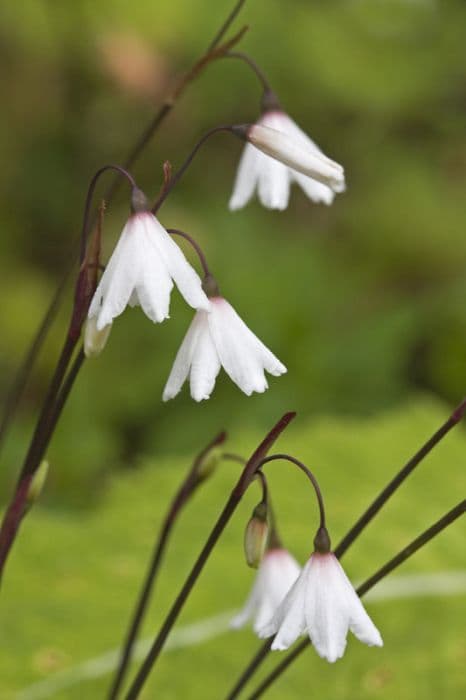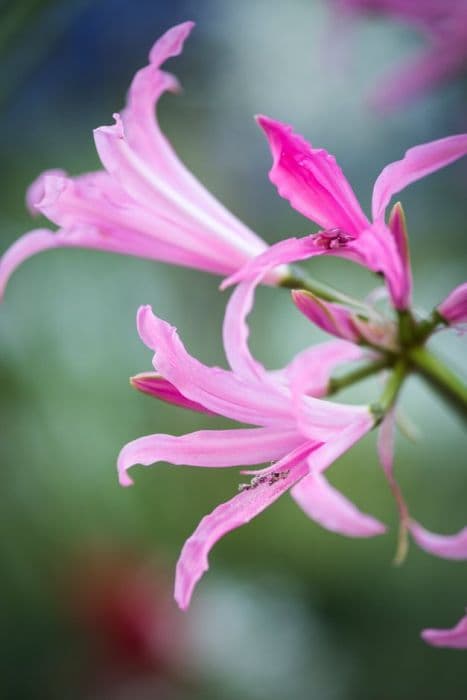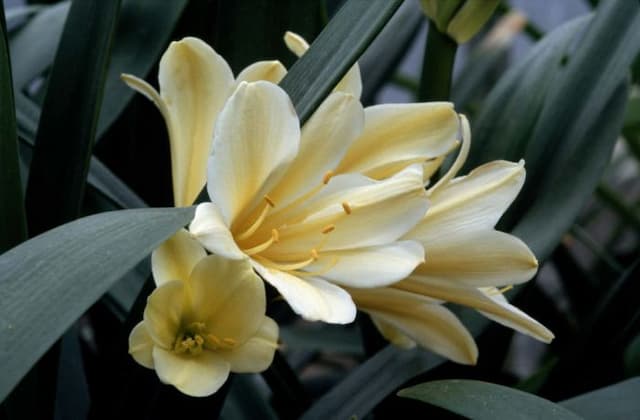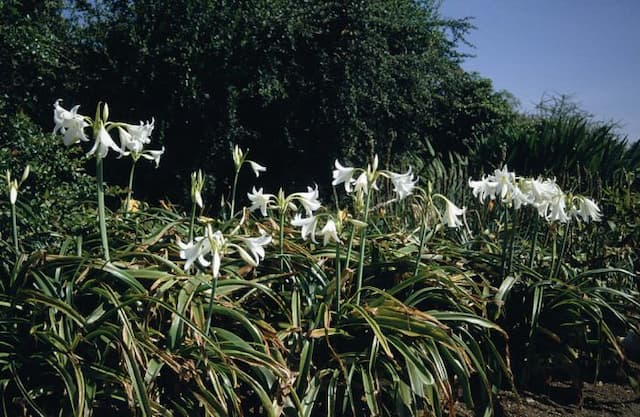Daffodil Narcissus 'Highfield Beauty' (8)

ABOUT
Narcissus 'Highfield Beauty' (8) is distinct for its striking flowers which are the main feature of the plant. The blooms have a classic daffodil form with a large central trumpet surrounded by a star-shaped whorl of petals. Although the exact hues can vary, the flowers are typically creamy white to soft yellow, often with a darker yellow or even an orange tint to the trumpet, giving the flowers a bi-colored appearance. The petals are broad and slightly overlapping, emanating from the center in a symmetrical fashion. The overall impression is one of gentle contrast and delicate beauty. The leaves of 'Highfield Beauty' are thin, strap-like, and green, forming a tufted clump from which the flower stems emerge. Each stem typically supports a single flower, which nods gracefully at the tip, indicating a certain elegance. The plant’s foliage complements the flowers and remains unobtrusive, allowing the blossoms to take center stage during their blooming season. The overall appearance of Narcissus 'Highfield Beauty' is one of simplicity and charm, making it a beloved choice for gardens and floral displays.
About this plant
 Names
NamesSynonyms
Daffodil, Jonquil, Narcissus.
Common names
Narcissus 'Highfield Beauty'
 Toxicity
ToxicityTo humans
The Narcissus 'Highfield Beauty', more commonly known as daffodil, is toxic to humans. All parts of the daffodil contain toxic alkaloids including lycorine. Ingestion can lead to symptoms that include nausea, vomiting, diarrhea, abdominal pain, and even more severe symptoms such as cardiac arrhythmias or neurological issues in cases of significant poisoning. Handling the bulbs can also cause skin irritation in sensitive individuals. Consumption of any part of the plant should be avoided to prevent these potential health issues.
To pets
For pets, particularly cats and dogs, the daffodil is also toxic. It contains lycorine and other alkaloids that can cause vomiting, salivation, diarrhea, convulsions, low blood pressure, tremors, and cardiac arrhythmias. In severe cases, ingesting daffodils can lead to major systemic upset, and could potentially be fatal if not treated promptly. It is advisable to keep pets away from these plants to prevent accidental ingestion and the accompanying health risks.
 Characteristics
CharacteristicsLife cycle
Perennials
Foliage type
Deciduous
Color of leaves
Green
Flower color
White
Height
1-1.5 feet (30-45 cm)
Spread
0.5 feet (15 cm)
Plant type
Bulb
Hardiness zones
3-9
Native area
Europe
Benefits
 General Benefits
General Benefits- Aesthetic Appeal: Adds vibrant yellow color and unique trumpet-shaped flowers to gardens and landscapes.
- Spring Bloom: Flowers in early to mid-spring, providing one of the season's first bursts of color.
- Ease of Care: Requires minimal maintenance, making it suitable for both novice and experienced gardeners.
- Drought Tolerance: Once established, it can withstand periods of low water, reducing the need for frequent irrigation.
- Resistance to Pests: Generally resistant to common garden pests, decreasing the need for chemical treatments.
- Attracts Pollinators: Attracts bees and butterflies, which are essential for the pollination of plants and the health of the ecosystem.
- Naturalizing: Has the ability to spread and naturalize an area over time, creating a fuller, more robust garden display.
- Cut Flower Use: Suitable for cutting and using in floral arrangements, bringing spring beauty indoors.
 Medical Properties
Medical PropertiesThis plant is not used for medical purposes.
 Air-purifying Qualities
Air-purifying QualitiesThis plant is not specifically known for air purifying qualities.
 Other Uses
Other Uses- Narcissus 'Highfield Beauty', commonly known as daffodil, can be used for natural dyeing, producing a range of yellow hues when used with different mordants.
- The bulbs of daffodils can be used as a pest control measure in gardens, as their toxic properties deter moles and rodents from the area.
- Daffodil flowers can be pressed and used in art projects like creating bookmarks, greeting cards, or other paper crafts for their shape and color.
- The sturdy stems of daffodils can be used in traditional weaving practices to create intricate designs in baskets or mats.
- Daffodils can play a role in companion planting, helping protect vegetables like tomatoes from pests due to their repellent properties.
- The essence of daffodils can be used in perfumery; although it is not common, these flowers can lend their fragrance to custom-made scents.
- Dried daffodil petals can be incorporated into homemade potpourri mixtures to add color and a subtle fragrance to rooms.
- Daffodil plants can be used in floral arrangements that follow the ikebana art form, symbolizing rebirth and new beginnings.
- Their appealing springtime blooms make daffodils suitable for inclusion in weddings as part of bouquets or table decorations, representing joy and happiness.
- Used in educational settings, the life cycle of the daffodil can demonstrate plant growth and seasonality to students in practical biology lessons.
Interesting Facts
 Feng Shui
Feng ShuiThe Daffodil is not used in Feng Shui practice.
 Zodiac Sign Compitability
Zodiac Sign CompitabilityThe Daffodil is not used in astrology practice.
 Plant Symbolism
Plant Symbolism- Rebirth and Renewal: Due to its early blooming, Narcissus, commonly known as daffodil, is often associated with spring and thus symbolizes new beginnings and the end of the cold, dormant period of winter.
- Unrequited Love: Stemming from the Greek myth of Narcissus who fell in love with his own reflection, daffodils can symbolize self-love or unrequited love.
- Hopes and Dreams: As daffodils are among the first flowers to bloom in spring, they tend to represent hope and the fulfillment of desires.
- Prosperity: Since daffodils typically bloom in clusters, they can be seen as a sign of wealth and prosperity.
- Vanity: Again echoing the tale of Narcissus, the flower sometimes represents excessive self-involvement and vanity.
- Good Fortune: In some cultures, daffodils are believed to bring good fortune, especially if the first bloom of the season is brought indoors.
- Insight: The bright, eye-like center of the daffodil can symbolize deeper awareness or enlightenment.
- Respect: Daffodils can also be a symbol of regard and respect for someone else's unique qualities.
 Water
WaterDaffodil 'Highfield Beauty' should be watered thoroughly when the soil feels dry to the touch, which is typically about once a week. The frequency, however, may increase during their active growth period in spring and decrease in the dormant season. Water the plant at the base to avoid wetting the foliage, using approximately 1 gallon of water for outdoor plantings. Ensure the soil is well-draining to prevent waterlogging. Allow the top 2 inches of soil to dry out before watering again to promote healthy root growth.
 Light
LightDaffodils prefer full sun to light shade, thriving best with at least 6 hours of direct sunlight daily. Plant Daffodil 'Highfield Beauty' in a spot that receives morning light and partial afternoon shade to protect them from intense heat, which can diminish blooming quality.
 Temperature
TemperatureDaffodils are hardy and can withstand cold down to about 20°F, but they prefer cooler temperatures between 50°F and 70°F for optimal growth. Avoid exposing 'Highfield Beauty' to temperatures above 80°F, which can impede their growth and flowering. The ideal temperature range to promote blooming is between 50°F and 60°F.
 Pruning
PruningPrune Daffodil 'Highfield Beauty' after flowering by deadheading spent blooms to maintain their appearance and prevent seeding. Leave the foliage intact until it yellows and brown, which typically takes 6 to 8 weeks, as this allows the bulbs to store energy for the next season. Pruning is generally done annually, after the blooming period.
 Cleaning
CleaningAs needed
 Soil
SoilDaffodil 'Highfield Beauty' thrives in well-draining soil with a slightly acidic to neutral pH of 6.0 to 7.0. A good soil mix can be made by combining loamy soil with organic matter such as peat moss or compost to enhance fertility and drainage. Perlite or sand can be added to further ensure proper drainage.
 Repotting
RepottingDaffodils generally do not require frequent repotting and can be left undisturbed for several years. It's advisable to repot or divide daffodil 'Highfield Beauty' every 3 to 5 years to ensure vigor and prevent overcrowding.
 Humidity & Misting
Humidity & MistingDaffodil 'Highfield Beauty' is tolerant of a wide range of humidity levels as long as it is planted in well-draining soil and not waterlogged. Outdoor ambient humidity is typically sufficient for this plant, without the need for any special humidity adjustments.
 Suitable locations
Suitable locationsIndoor
Place in bright indirect light, ensure good pot drainage.
Outdoor
Plant in well-drained soil, full to partial sun exposure.
Hardiness zone
3-9 USDA
 Life cycle
Life cycleNarcissus 'Highfield Beauty', commonly known as daffodil, begins its life cycle as a bulb, which is a dormant stage that can survive harsh conditions. In early spring, the bulb breaks dormancy, and growth resumes, leading to the emergence of shoots and strap-like leaves from the ground. Following the foliage, flower buds develop and bloom into the characteristic trumpet-shaped blossoms that are often yellow or white, with a central corona. After the flowering stage, the plant undergoes pollination, which can be facilitated by insects attracted to the flowers, resulting in the production of seeds within a capsule. Once the flowering and seed production are complete, the above-ground parts of the daffodil begin to die back as the plant enters a period of dormancy, redirecting energy to the bulb for the next growth cycle. The cycle repeats annually with the bulb remaining in the soil, accumulating nutrients and energy for the subsequent spring's growth.
 Propogation
PropogationPropogation time
Spring-Early Summer
The Narcissus 'Highfield Beauty', commonly known as daffodil, is typically propagated through division of bulbs, which is the most popular method for this plant. This process usually takes place in late summer to early fall, after the foliage has died back. To propagate, carefully dig up the clumps of bulbs and gently separate the offsets, which are smaller bulbs that have formed at the base of the mother bulb, from the main bulb. These offsets can then be replanted immediately, placing them at a depth of about 6 inches (approximately 15 cm) and spaced 3 to 6 inches apart (about 7.5 to 15 cm) to allow for adequate room for growth. It is essential to water the newly planted bulbs thoroughly to help establish them. Over time, these offsets will grow into mature bulbs and produce their own flowers, continuing the cycle of propagation.









